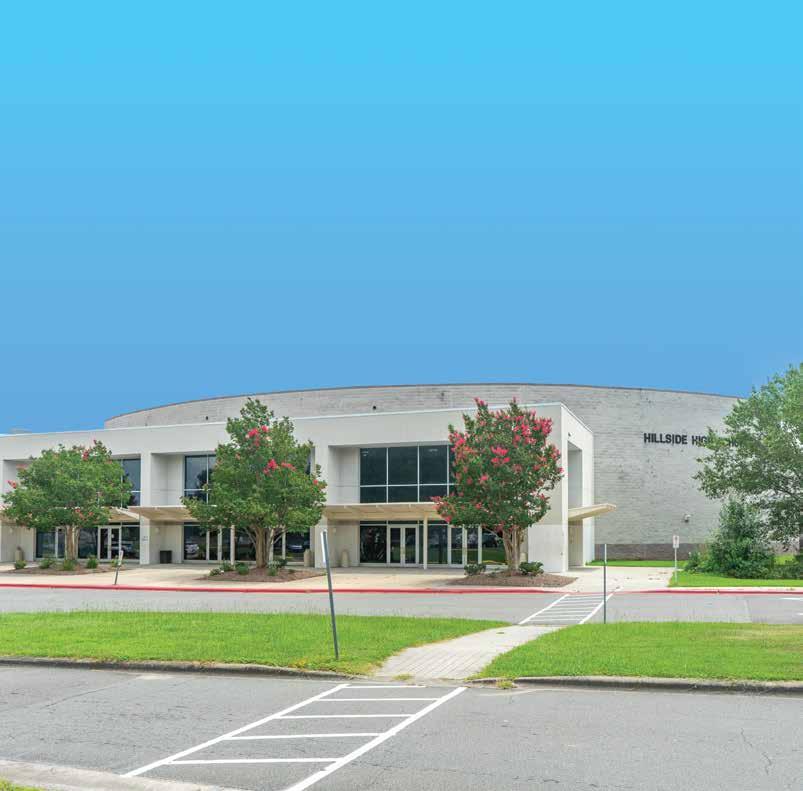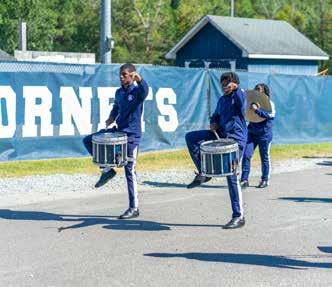
6 minute read
A LEGACY OF LONGEVITY AND BELONGING
hen Dr. William Logan was asked to take the reins at the historic Hillside High School as principal after nearly 10 years of service in various capacities, his thoughts immediately turned to the students and what more he could do for them. Naturally, he accepted. Another decade later, he’s still there for them.
Hillside celebrates 10 decades this year, which makes it even more special for this veteran educator. There are 100 years to celebrate, and the list of achievements and celebrations is long and wide.
Hillside’s longevity is a sign of pride, resilience, and strength — characteristics Dr. Logan reminds his staff and students that they possess and that no one or nothing can take away. The school was once one of 300 historically Black high schools in the state of North Carolina. It now stands as one of only five — and the oldest — that remain open and active.
Dr. Logan says that getting students to believe in themselves and in their own potential, and reminding staff that they have the capacity to make a difference in the lives of their students, is a persistent mantra that he repeats and by which he leads. He says the silent battle he fights is to reveal that the Hillside experience, for those who are curious enough to investigate, is totally different from naysayers’ perceptions.
“I allow the students’ and teachers’ successes to speak for themselves,” he says.
Hillside has shown how that should be done.
The district’s Beginning Teacher of the Year, Kiara Thorpe, spoke to this when she was honored for her work last school year.
“There’s so much legacy, there are so many celebrities. There are so many people who have done amazing work and we continue to push out leaders and critical thinkers. Our actions will always outshine what people say. When there are doubts, I know to keep my nose close to the ground and keep working,” she said.
The centennial will celebrate all of the school’s successes and longevity. A 100-year timeline is being created to explain the school’s history and meaning to its students, teachers, and community, past and present. The timeline will be used as a learning tool in perpetuity.
“So many people do not understand the history of the school, and there’s a misunderstanding of the community’s love for the school,” said Dr. Logan. There’s so much love in fact that organizations are willing to fundraise projects that contribute to its legacy. Just this spring, The Triangle Park Chapter of The Links unveiled a newly constructed sound studio at the school for students, staff, and the community to use.
Dr. Logan says the timeline will be unveiled during a community ceremony — date and time to be announced — and portraits of two of the school’s principals will be added to the wall displaying the institution’s lead learners. Nameplates with the principals’ names and dates of tenure will be placed under each portrait.
Noting the community’s involvement in the life of the school, Dr. Logan shared that the Hillside High School Centennial Sub-Committee took care of the celebrations this past spring; the school itself will take the baton and lead the celebration this fall.
Hillside High School Turns 100

Hillside High School Turns 100




A speaker series and documentary are also being planned to pay homage to the school’s history.
The History Of Hillside
The largest Black schools in Durham prior to the building of Whitted School in 1887 were the Ledger Public School in Hayti, under the supervision of Miss Ledger, and the Hack Road Public School, where James Whitted, “a highly respected man of mixed races (Black and Indian) who had managed to educate himself,” was superintendent.
In 1887, the Whitted School existed as the James A. Whitted High School, in honor of its first principal. The school, which was located on the corner of Blackwell and Pettigrew Streets, burned in 1888 and was relocated to a Bull Factory warehouse. In 1890, 161 pupils attended the school’s six grades. Whitted taught the upper grades, William G. Pearson taught the middle grades, and two female teachers taught the first and second grades.
The first class graduated from the ninth grade of Whitted School in 1896. Also in 1896, a permanent brick building was constructed on Proctor and Ramsey Street for Black children at a cost of $8,000. In 1899, the building was destroyed and reconstructed, but students were housed in churches during that school year. In 1901, another Black school, West End, was built. At this time, 707 students were enrolled in the Durham Black graded schools. In 1909, the East End School was constructed.
Hillside High School Turns 100


Only nine grades existed at Whitted from 1896 until 1911, but in 1911 a tenth grade was added. The 11th grade was added in 1918.
The Whitted School, which was in poor condition, burned in 1921, and students had to attend double sessions at East End and West End Schools. John Sprunt Hill, a leading Durham citizen, donated land for a new building on Pine and Umstead Street, which was named Hillside Park High School in honor of the donor and due to the fact that the school was located next to Hillside Park, a public cityowned Black Park. The class of 1944 was the first to graduate under the 12-year system. A public address system was installed in the school in 1943 at a cost of $150.
The “Park” was dropped from the name Hillside High School in 1943. In 1950, because of overcrowding in the high school, the Hillside High School students moved into what was then called Whitted Junior High School, located near the campus of North Carolina Central University (NCCU) and now the site of an NCCU science classroom building, and the Whitted Junior High School students moved into the old Hillside Park High School building closer to downtown Durham. The schools’ buildings also swapped names. Hillside High School at this time only enrolled grades 10, 11, and 12 and Whitted Junior High School enrolled seven, eight, and nine.
Additions of an auditorium, cafeteria, auto shop, classroom, and gymnasium were made to accommodate a large number of transferred high school students in 1949. A classroom annex was added to the Hillside building in 1962. In 1966, a new library was added. A new band room was constructed in 1975. Hillside was relocated to a new building in 1995.
Eunice Sanders was Hillside’s principal from 2002 to 2006, resigning after the 2005-2006 school year to move to an administrative position within the Durham Public Schools Central Office. Earl Pappy was the principal of Hillside from 2006 to 2009. He was followed by Hans Lassiter who served as principal from 2009-2012.
The current principal is Dr. William Logan.










